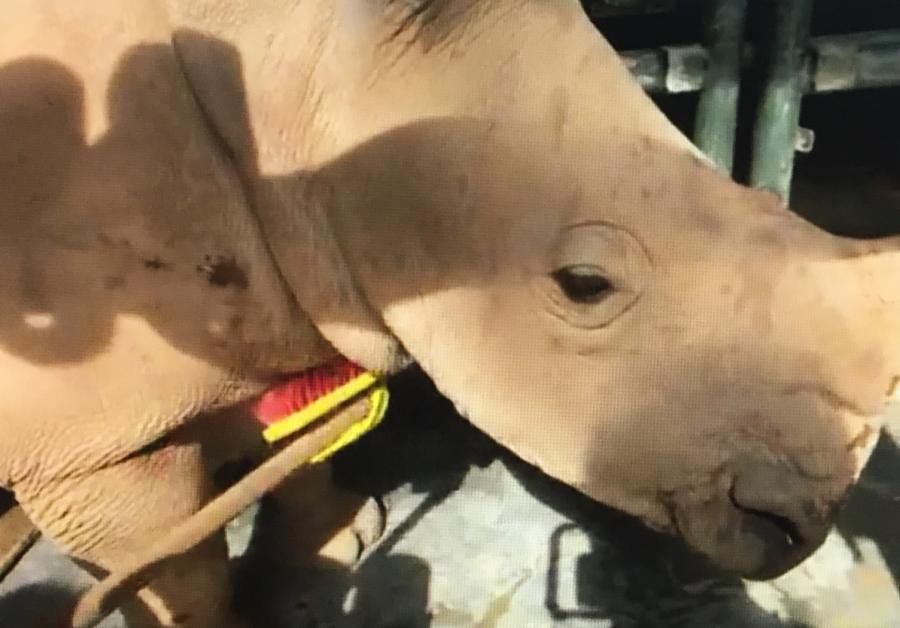Hello from the Wild Side!

“How are you all feeling this morning? Have you had your breakfast?” asks Nur Ilya Sofia binte Omar, the moderator of a recent Saturday morning webinar hosted by Wildlife Reserves Singapore (WRS) titled “Hello from the Wild Side.”
While waiting for more people to connect to the broadcast, Sophia reads viewer comments that are hidden from the audience, including “I like tigers,” “I love bunnies,” and “My girls like cheetahs.” Her backdrop is a photo of two giraffes, one sticking out its tongue, while the other looks directly at the camera.
Sophia’s video appears on Zoom on top of a live feed from the Singapore Zoo’s White Rhino habitat, where several of the enormous, herbivorous mammals are enjoying their own morning meal. The main part of the screen is occupied by a slide advising viewers to grab a seat. Some 350 users signed up for the webinar to learn how zookeepers care for one of WRS’ newest residents, a four-month-old, 200-kilogram baby rhino named Tayo.
Before long, the feed switches to Siti Nurindah Aliyah Ali, a WRS animal keeper who leads us through a gate to a back-of-house area where Tayo and his mom, Nana, are in an open pen. Holding a scrub brush on a long wooden pole, Nurindah calls Tayo over for a stomach rub. Afterward, Tayo nestles his nose into Nurindah’s shoulder.
“Hello from the Wild Side” is one of several new virtual offerings launched by Wildlife Reserves Singapore—the operator of the Singapore Zoo, Night Safari, River Safari, and Jurong Bird Park—since the onset of the COVID-19 pandemic.
“The idea was first mooted in April last year when Singapore went into its national lockdown for three months due to the pandemic and our wildlife parks had to close for the first time in our 50 years of operations,” explains WRS Chief Marketing Officer Irene Lin. “Virtual experiences became the only option for us to continue to engage our audience and connect people to wildlife in a meaningful way. That spurred creativity.”
“Our wildlife parks used to have ‘keepers chit chat’ sessions where our animal care team got to interact and engage with guests, but many of these activities had to be suspended as part of our safe management measures due to the ongoing pandemic,” she adds.
As many as 1,000 simultaneous, unique viewers can attend the half-hour webinars, which are priced at SG$10 per screen. Since its launch in May 2020, the program has reached more than 96,000 individuals, grassroots groups, and corporates.
The price tag of virtually programming is significantly more affordable than in-person backstage events, which range from SG$98 for a one-hour reptile tour to SG$600 for a three-hour private tour. Currently, in-person tours are limited to two participants due to government health restrictions; in normal times, up to seven people may join an in-person tour.
WRS’ virtual programs are conceptualized in-house, with collaboration from the marketing, animal presentation, zoology, and veterinary teams. A team of five—including a cameraperson, Zoom administrator, and chat moderator—produce each fortnightly segment. In addition to meeting the Singapore Zoo’s baby rhino, viewers have been taken into WRS’ animal hospital, an area not usually open to the public, to witness treatments in real time. Another segment presents Buddy the Golden Retriever and Mio the Scarlet Macaw to the audience.
Currently, government rules still limit attendance in Singapore parks. The country’s international borders are still largely closed as well. However, even when these restrictions are lifted, Wildlife Reserves Singapore expects virtual programming to complement its in-house offerings.
“Nothing beats being able to experience our parks physically,” says Lin. “Real-world in-park experiences will always be our main focus. We are working on integrating the ‘Hello from the Wild Side’ experience as part of our park campaigns so guests can interact with us before and after their park visit.”
Additional Virtual Offerings from Wildlife Reserves Singapore:
- Personalized Messages: For SG$50-80, guests can order a birthday song or other message from Amigo the Yellow-Naped Amazon Parrot, Moe the Capybara, or African penguins Ben and Bella. Amigo can sing in three languages; Moe, Ben, and Bella are filmed alongside a trainer who reads the message on their behalf.
- Backstage Passes: 30–45-minute private bookings, largely for corporations. A session at the Jurong Bird Park is priced from SG$2,000 per session, while a backstage pass to visit the Singapore Zoo’s elephants starts at SG$2,800.
- My Animal Buddy: A free online portal for young children with live chats, shows, interactive videos, and resources for parents.
- E-learning: A series of programs, for student of all ages, from preschool through secondary. Most sessions are booked directly by schools at SG$300 per session.
Five Tips for Virtual Programming:
- Buy camera equipment that is light and mobile so it’s easy for the team to maneuver in tight spaces.
- Use rigs to hold equipment to ensure streaming footage is stable and steady.
- Curate content specifically for online broadcast; don’t replicate in-person tours.
- Rehearse! Virtual tours are not the same as the in-person interactions to which a team is likely more accustomed. Train presenters for video and continue to practice, taking on board viewer feedback.
- Be clear about intent and stick to fundamentals. Virtual Programs offer innovative new revenue streams, but they will only be successful if they are in line with an organization’s purpose and culture.
